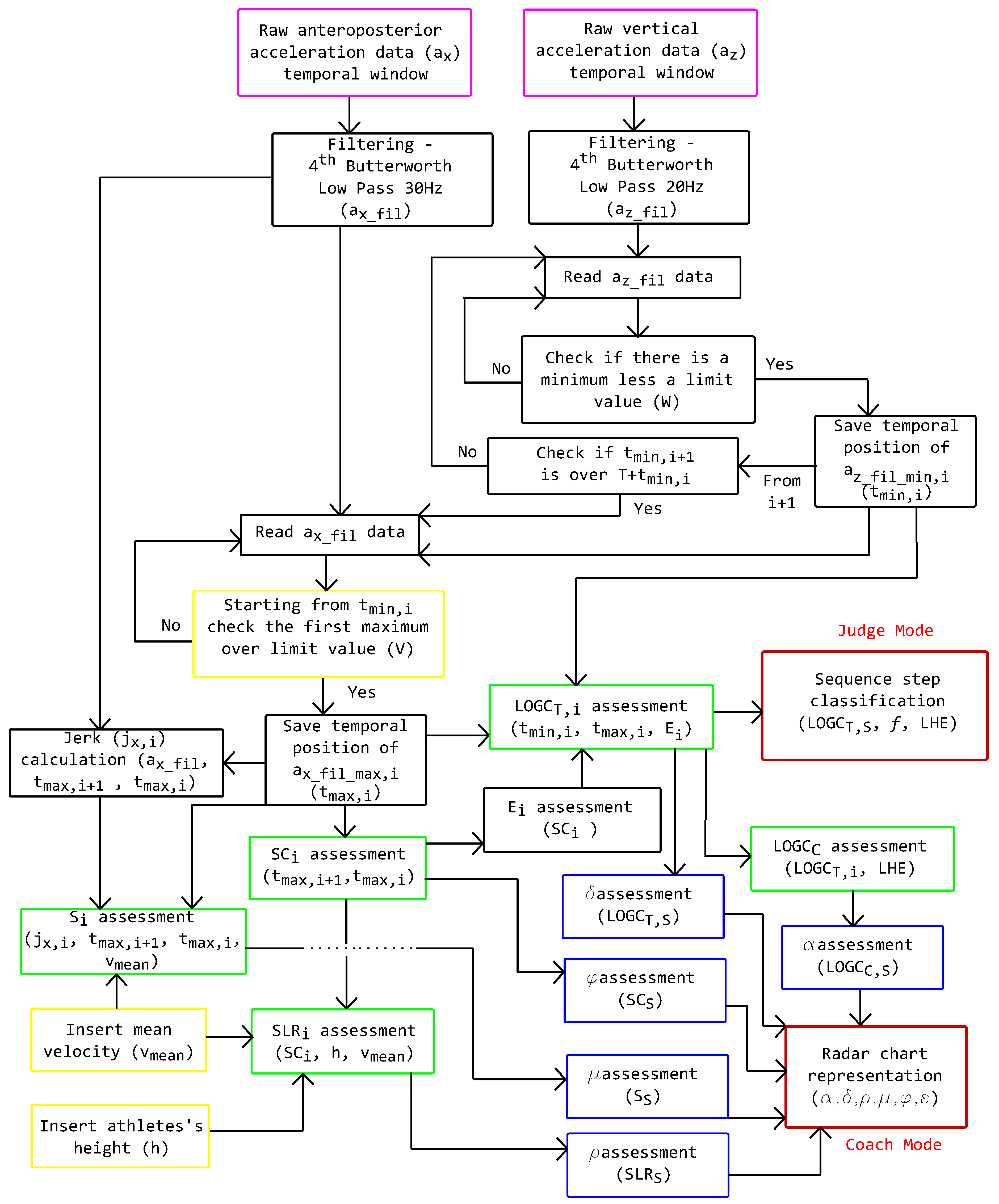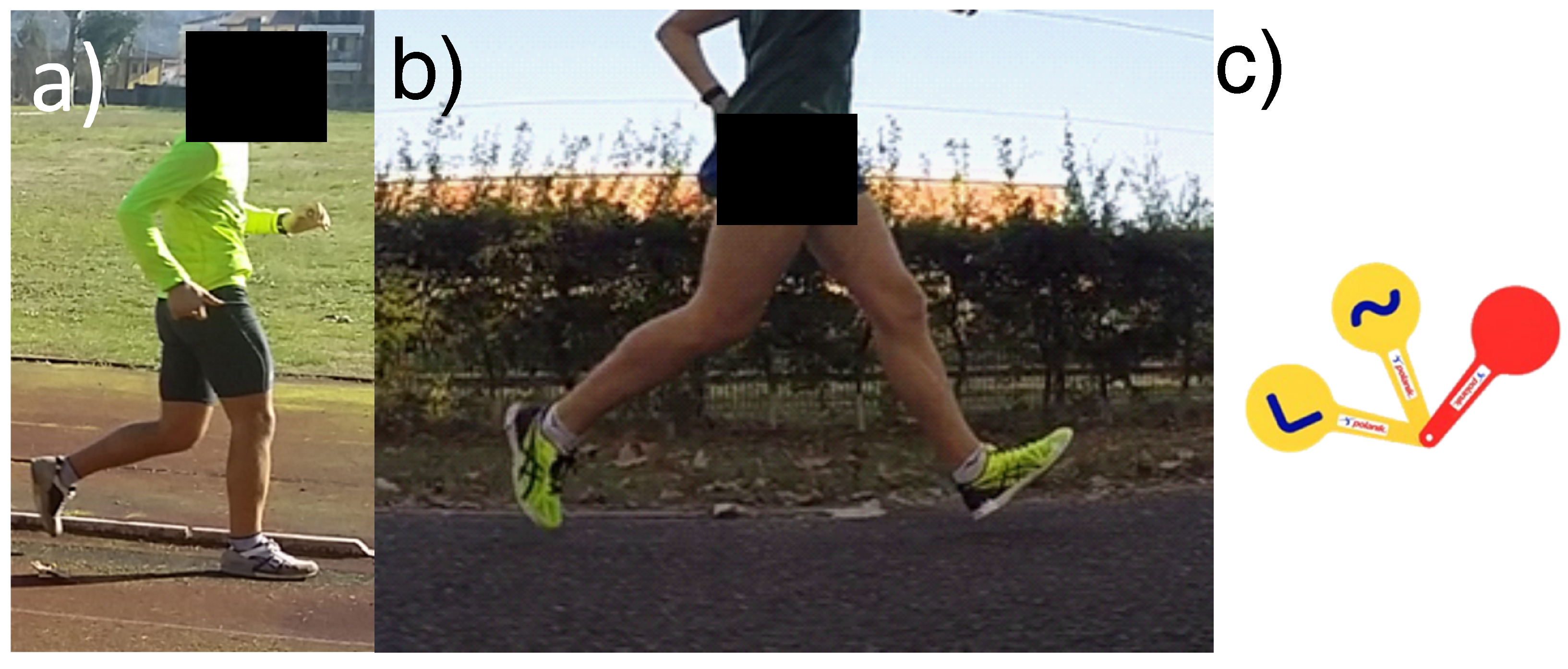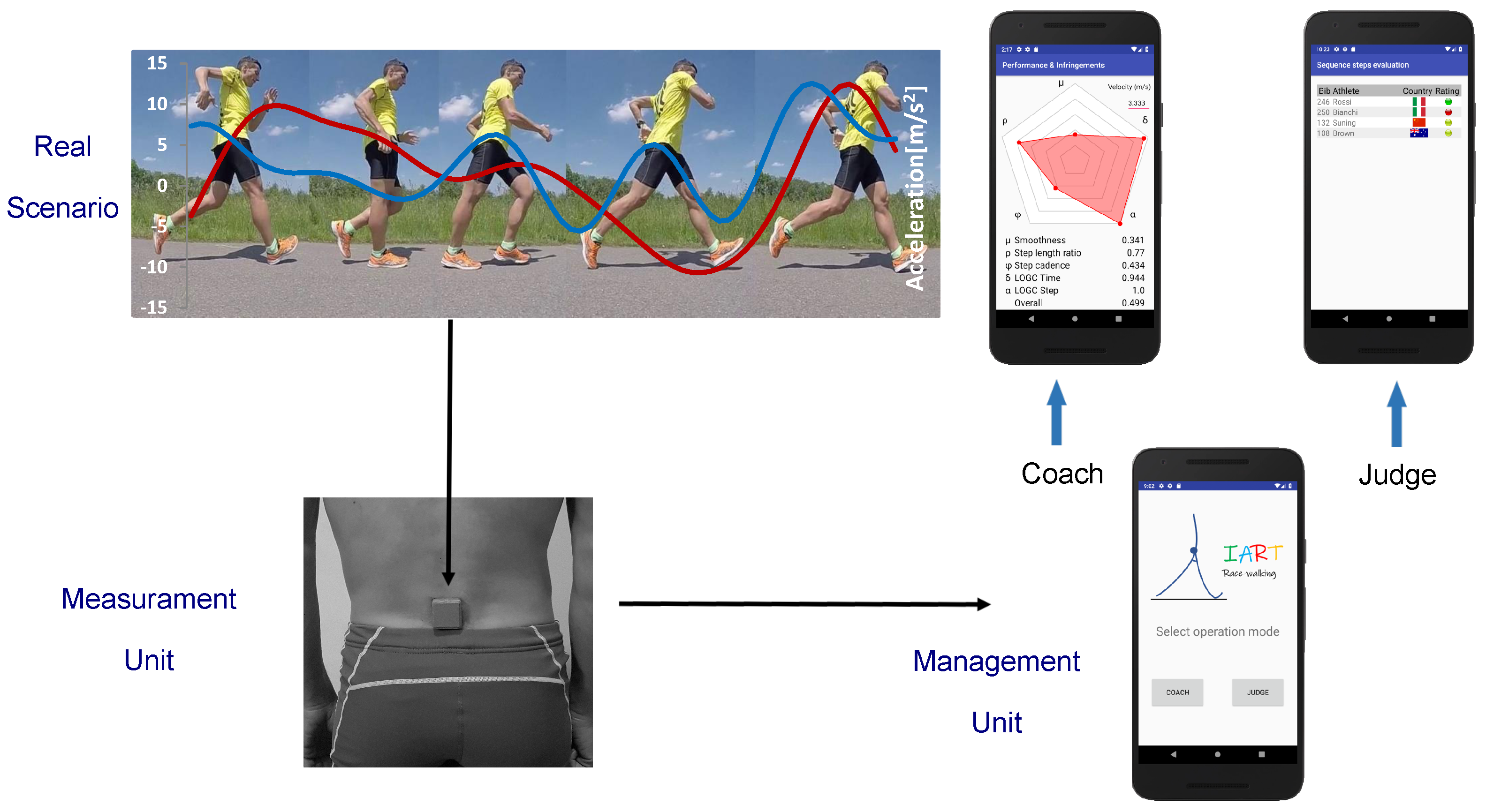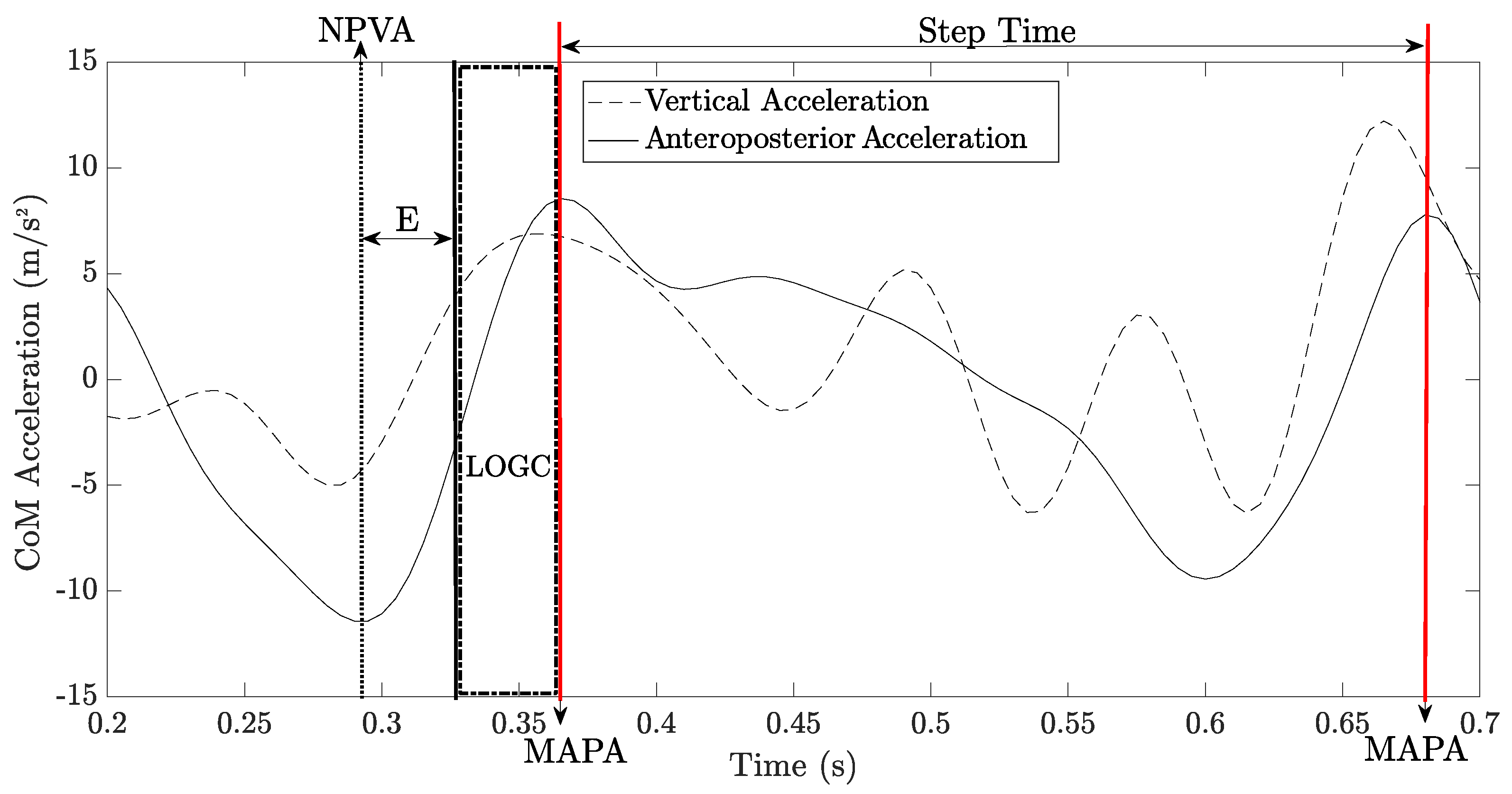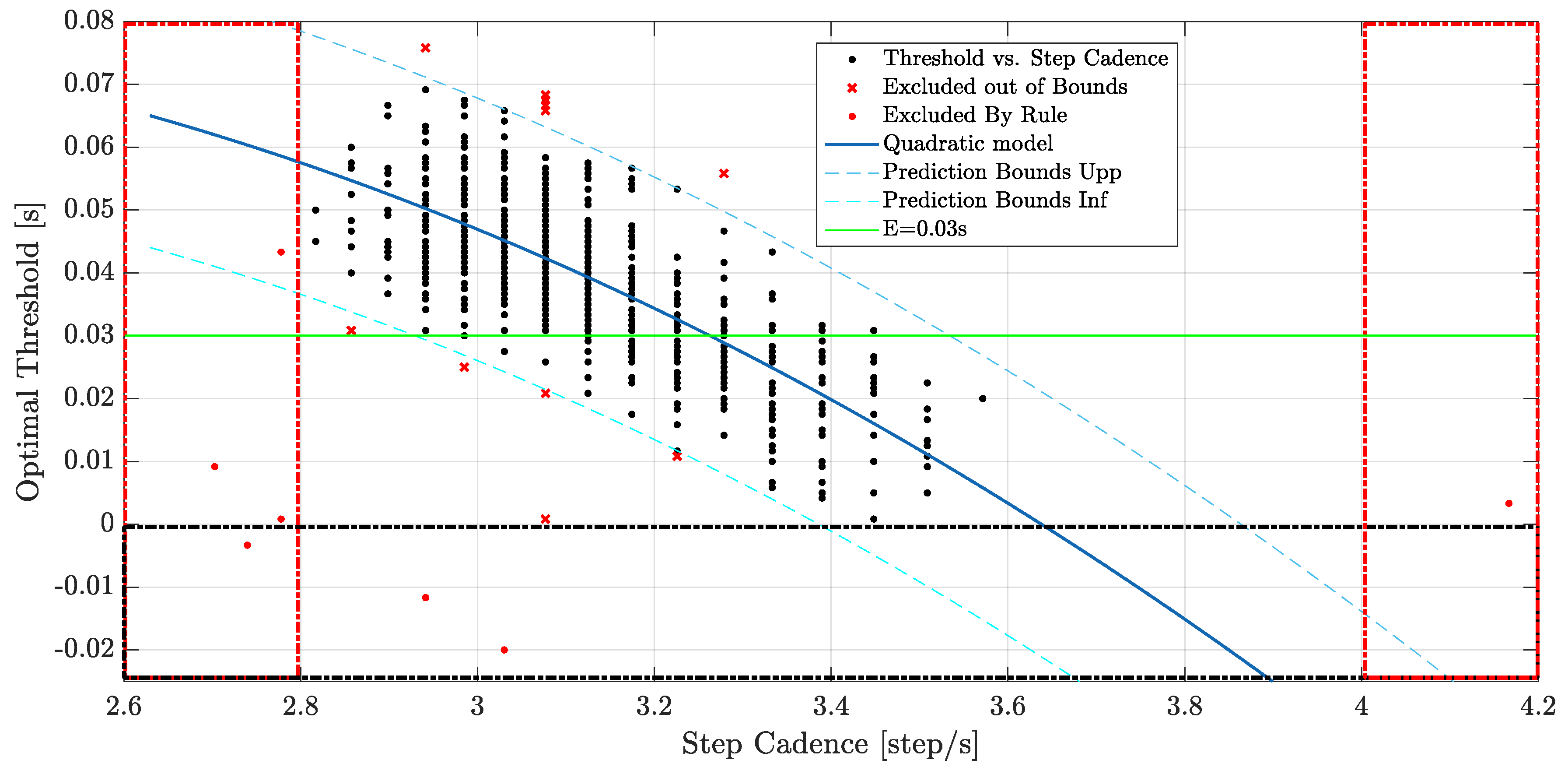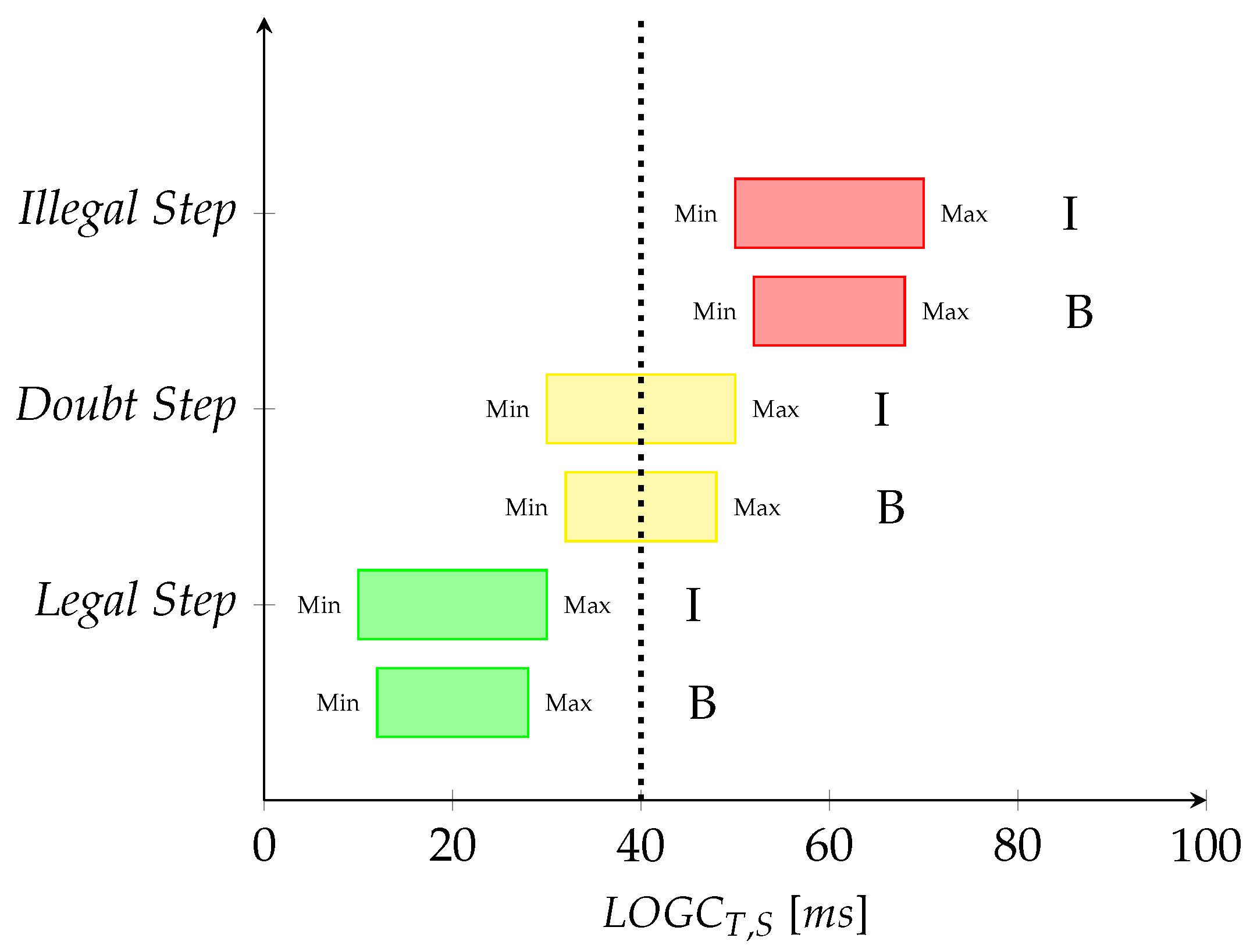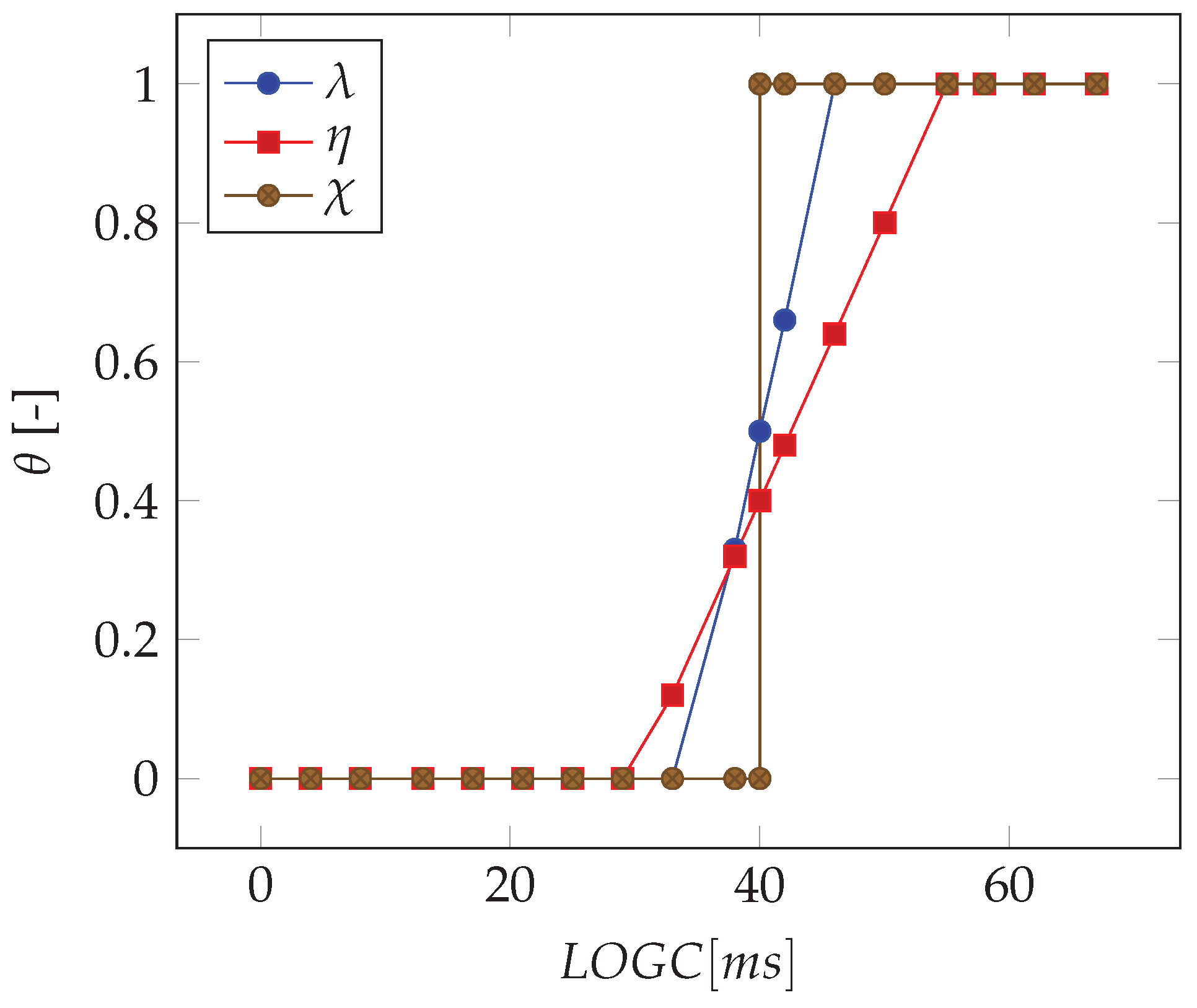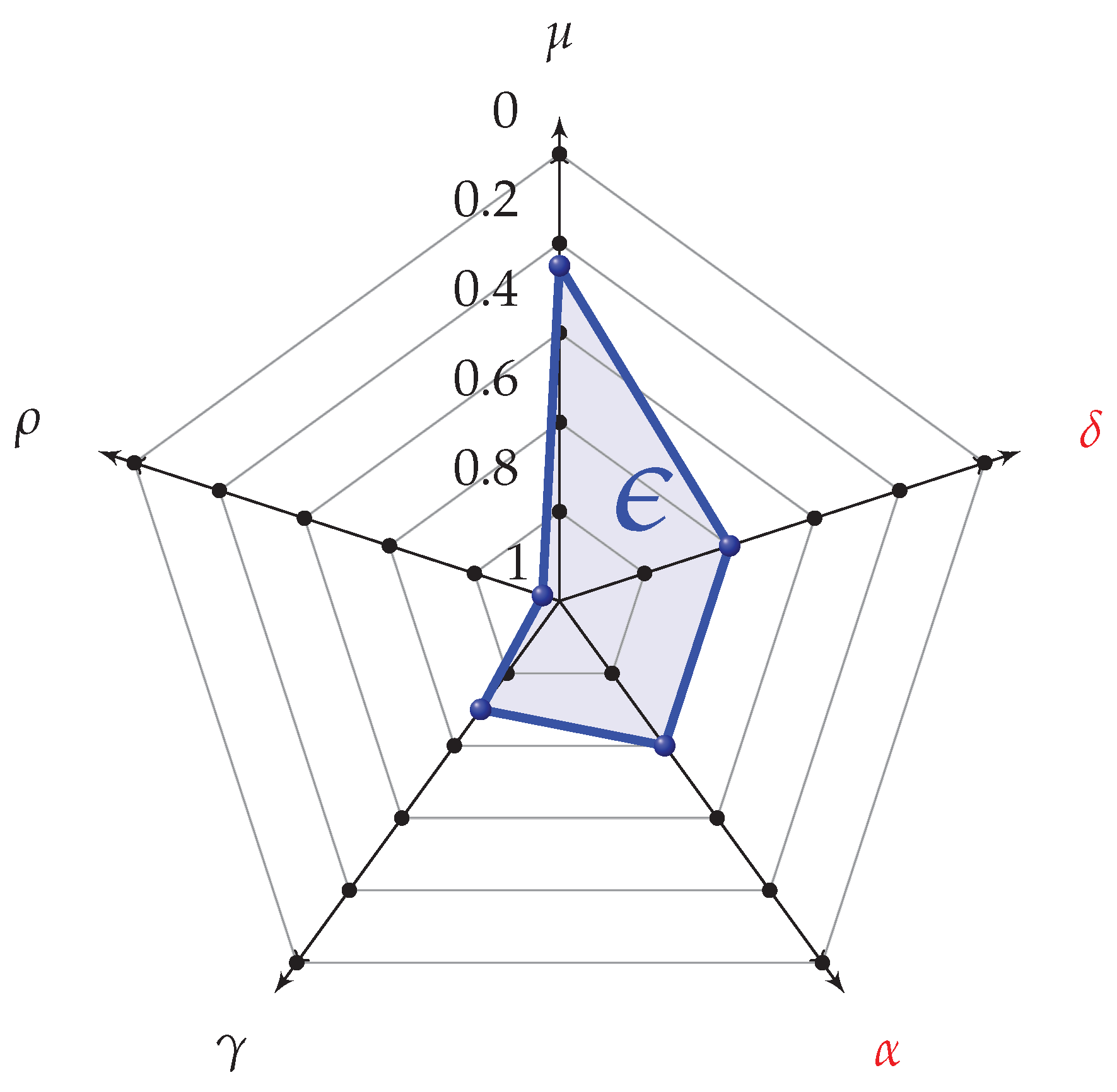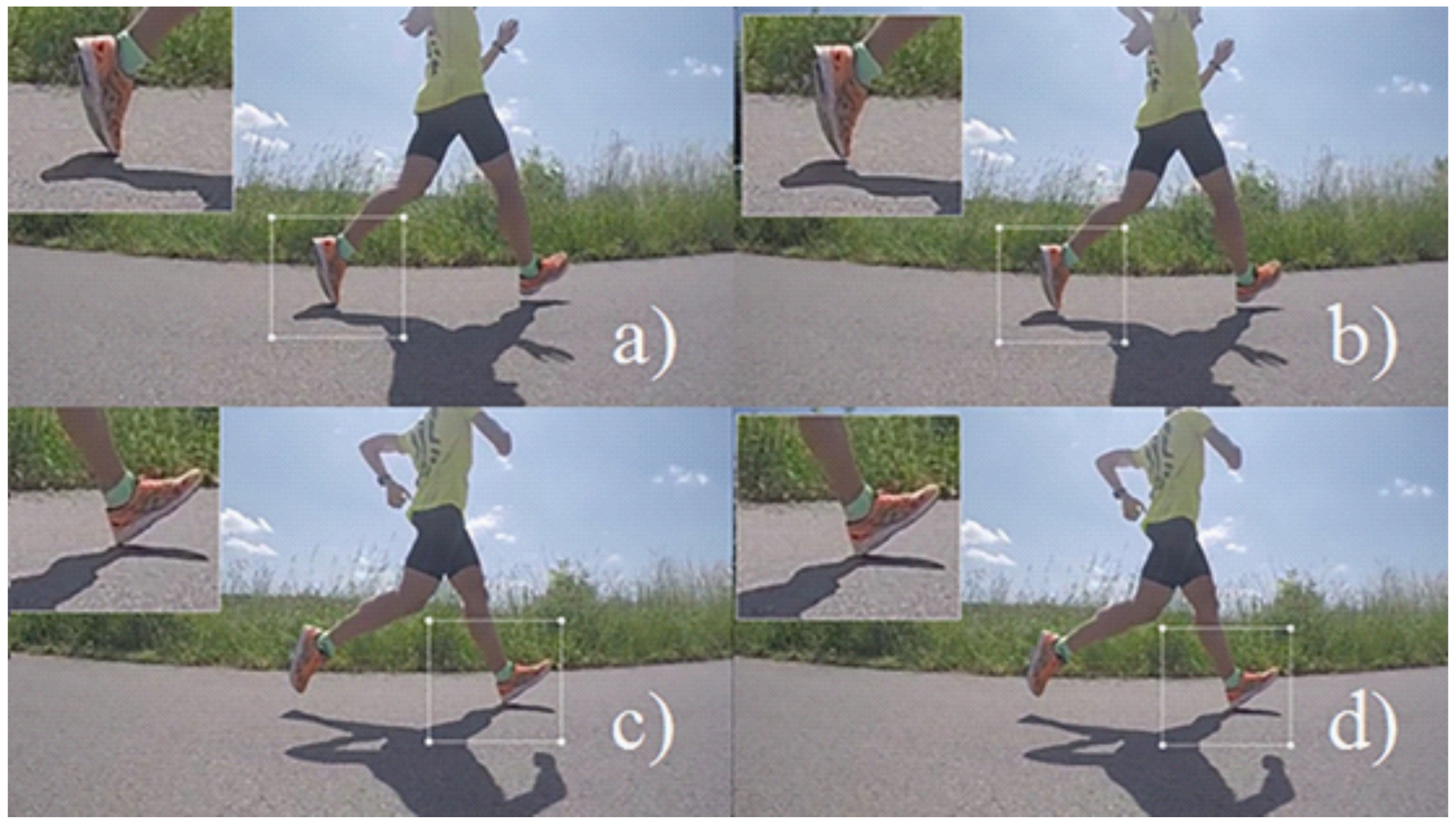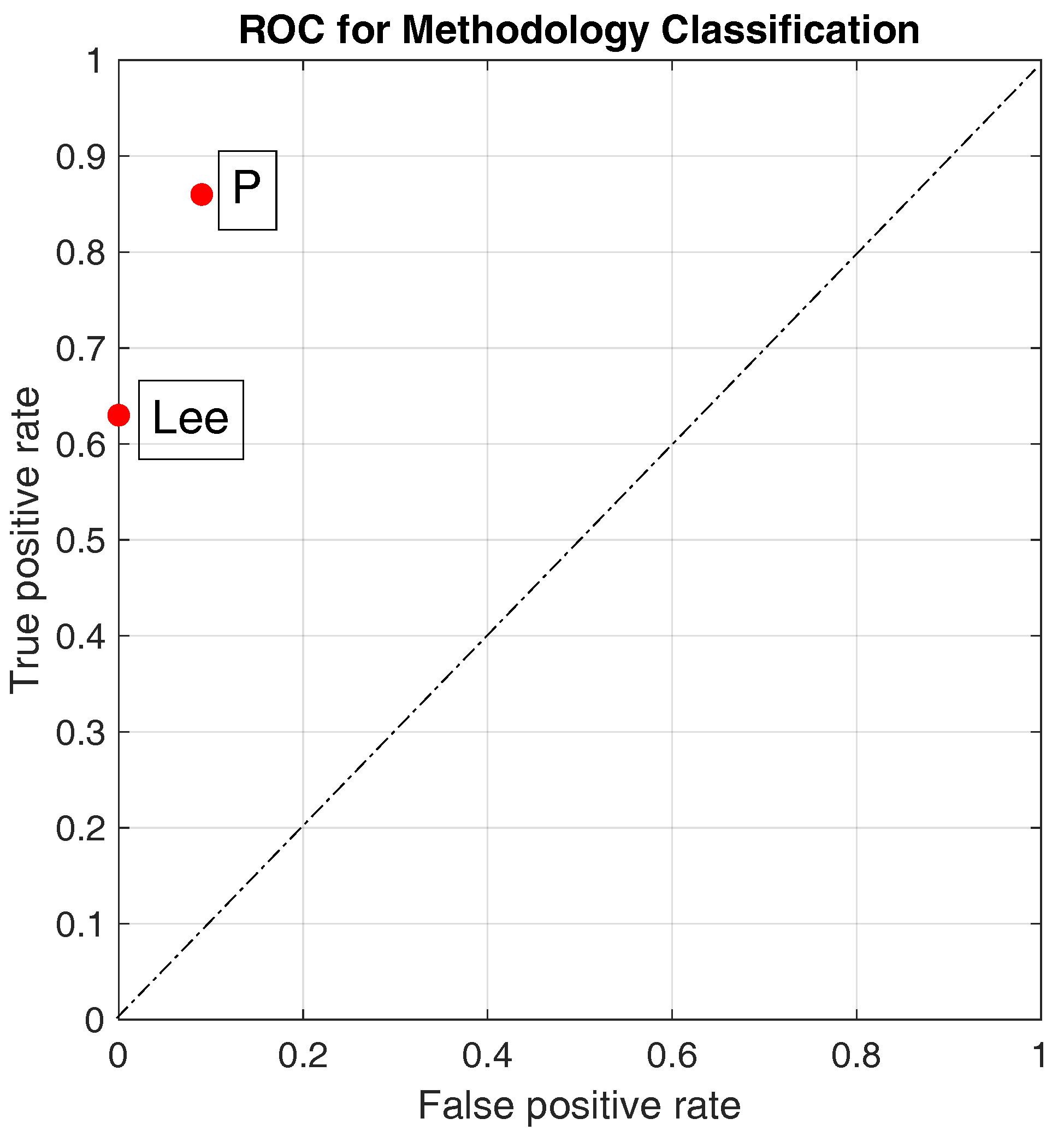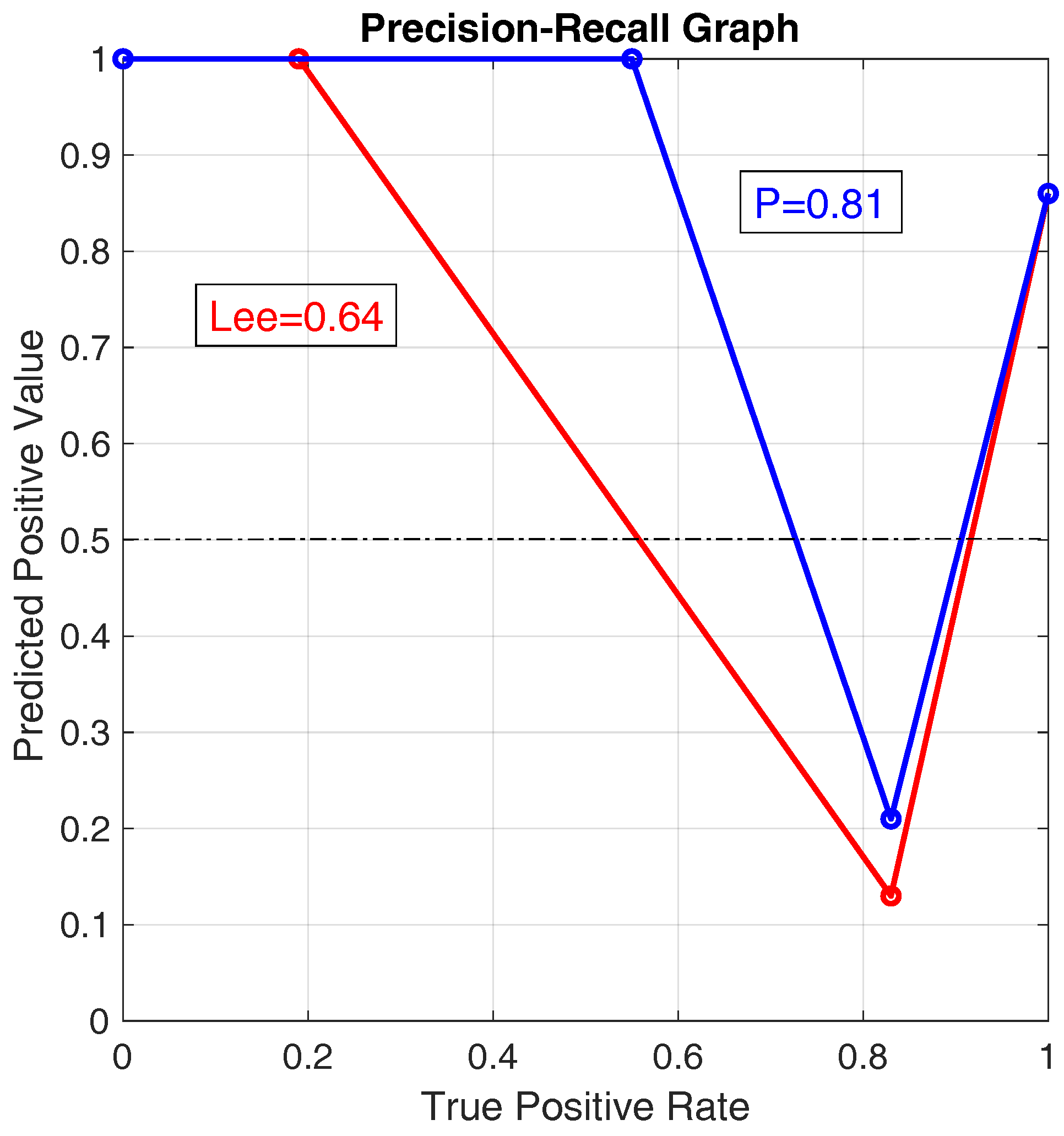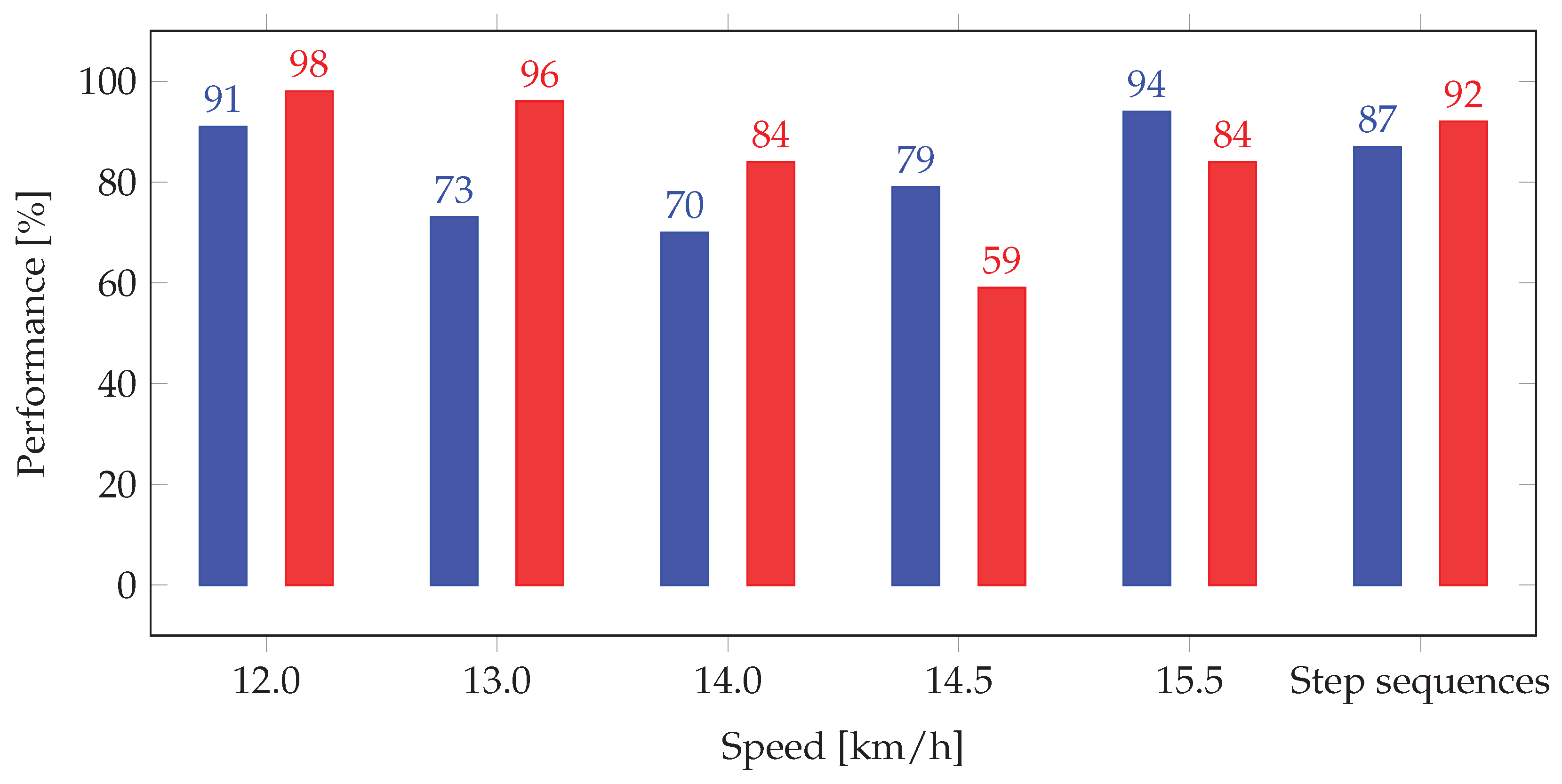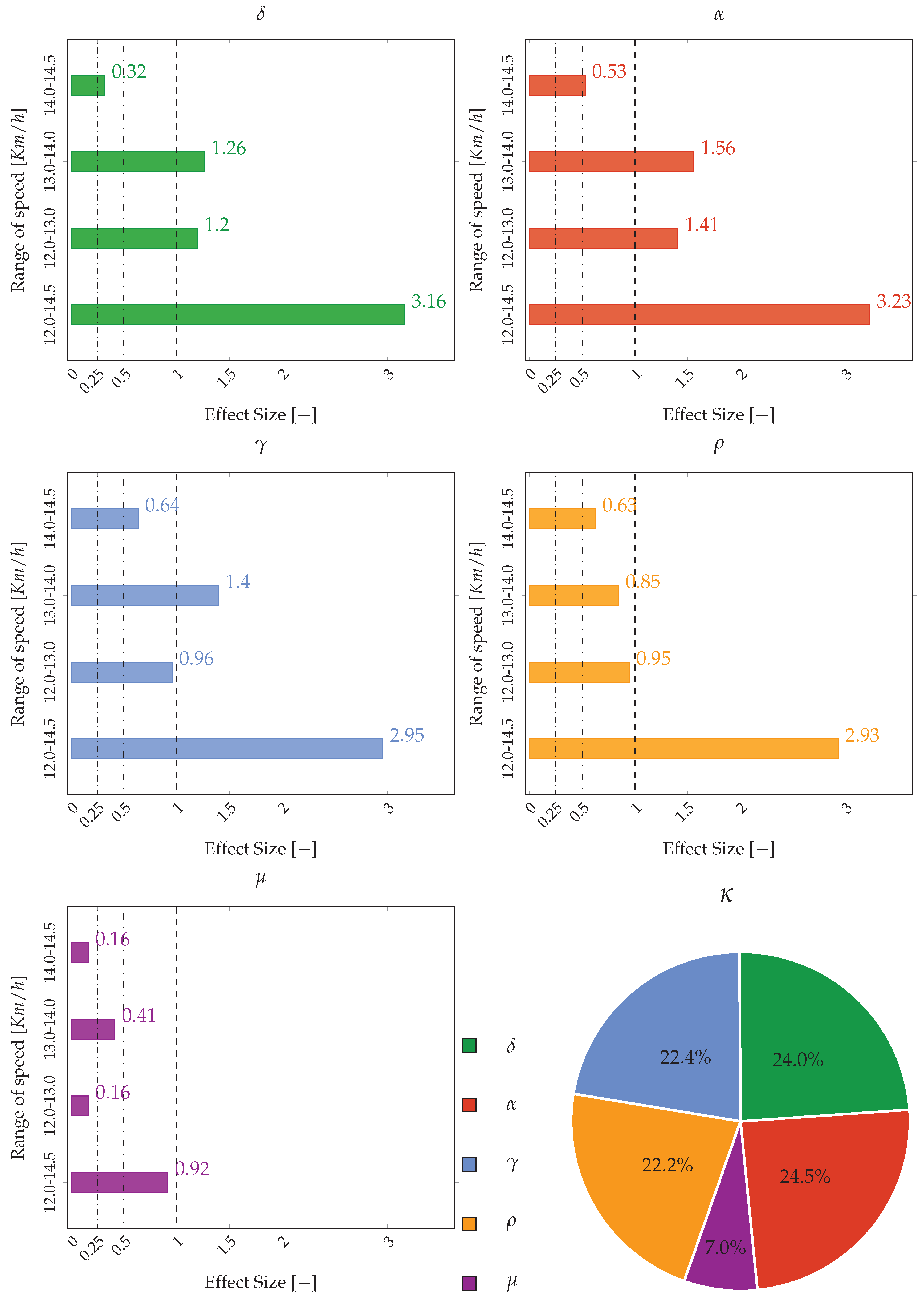Figure 1.
Infringements in race walking: (a) athlete in bent knee infringement (with a flexion of the knee before the vertical upright position) and (b) athlete in LOGC infringement; (c) yellow paddles with the two symbols associated with the two infringements (“<”: bent knee; “∼” LOGC) and red paddle (associated with the disqualification of the athlete).
Figure 1.
Infringements in race walking: (a) athlete in bent knee infringement (with a flexion of the knee before the vertical upright position) and (b) athlete in LOGC infringement; (c) yellow paddles with the two symbols associated with the two infringements (“<”: bent knee; “∼” LOGC) and red paddle (associated with the disqualification of the athlete).
Figure 2.
Basic architecture of IART. On the top-left, photo sequence of a real scenario with the acceleration data of CoM (red, vertical; blue, anteroposterior). On the bottom-left, the measurement unit placed at the end of athlete’s column vertebra. On the right, the management unit with a focus on the two modes of functionalities, as shown on the mobile app: coach mode and judge mode.
Figure 2.
Basic architecture of IART. On the top-left, photo sequence of a real scenario with the acceleration data of CoM (red, vertical; blue, anteroposterior). On the bottom-left, the measurement unit placed at the end of athlete’s column vertebra. On the right, the management unit with a focus on the two modes of functionalities, as shown on the mobile app: coach mode and judge mode.
Figure 3.
The correlation between the approximated CoM accelerations and temporal events (NPVA: temporal instant of negative peak vertical acceleration; MAPA: temporal instant of maximum anteroposterior acceleration). The temporal distance
E is the threshold value for loss of ground contact (LOGC) assessment. The temporal distance between two following MAPA represents the step time. Notice that, differently from Equation
1, we have used the following nomenclature; NPVA =
; MAPA =
.
Figure 3.
The correlation between the approximated CoM accelerations and temporal events (NPVA: temporal instant of negative peak vertical acceleration; MAPA: temporal instant of maximum anteroposterior acceleration). The temporal distance
E is the threshold value for loss of ground contact (LOGC) assessment. The temporal distance between two following MAPA represents the step time. Notice that, differently from Equation
1, we have used the following nomenclature; NPVA =
; MAPA =
.
Figure 4.
Scatter plot of optimal threshold values as function of the step cadence. Areas highlighted by red and black dash-dot lines are excluded from the analysis, respectively, for step cadence and for optimal threshold values.
Figure 4.
Scatter plot of optimal threshold values as function of the step cadence. Areas highlighted by red and black dash-dot lines are excluded from the analysis, respectively, for step cadence and for optimal threshold values.
Figure 5.
Plot of normal probability of residuals (response optimal threshold).
Figure 5.
Plot of normal probability of residuals (response optimal threshold).
Figure 6.
Acceleration data. Left, vertical accelerations close to the bottom point of the cycle; right, anteroposterior accelerations close to the maximum point of the cycle. On the abscissa axis, the time evaluated as the number of samples captured.
Figure 6.
Acceleration data. Left, vertical accelerations close to the bottom point of the cycle; right, anteroposterior accelerations close to the maximum point of the cycle. On the abscissa axis, the time evaluated as the number of samples captured.
Figure 7.
Three-levels step classification. On the x-axis, the values of expressed in [ms]. On the y-axis, the classification of steps. Green, “legal” steps; yellow, “doubt” steps; red, “illegal” steps. I: inertial classification; B: benchmark classification (from the high-speed camera). The vertical dotted line represents the limit of human eye (LHE) value (fixed equal to 40 ms).
Figure 7.
Three-levels step classification. On the x-axis, the values of expressed in [ms]. On the y-axis, the classification of steps. Green, “legal” steps; yellow, “doubt” steps; red, “illegal” steps. I: inertial classification; B: benchmark classification (from the high-speed camera). The vertical dotted line represents the limit of human eye (LHE) value (fixed equal to 40 ms).
Figure 8.
Membership functions for the inertial sensor () and the video benchmark system (). is the graphical representation of the binary classification. represents the output values of the functions.
Figure 8.
Membership functions for the inertial sensor () and the video benchmark system (). is the graphical representation of the binary classification. represents the output values of the functions.
Figure 9.
Radar chart representation of the five biomechanical indices. The red indices on the right ( and ) are related to infringements, and the black indices on the left (, ) are related to performance. The blue opacity area () represents the synthetic index.
Figure 9.
Radar chart representation of the five biomechanical indices. The red indices on the right ( and ) are related to infringements, and the black indices on the left (, ) are related to performance. The blue opacity area () represents the synthetic index.
Figure 10.
Photo sequence with magnifying glass focused on the left foot (near the TOE, upper pictures) and on the right foot (near the HSE, bottom pictures). (a) Last image with visible ground contact of left foot. (b) First image without the last visible ground contact of left foot. (c) Last image without visible ground contact of right foot; (d) First image with visible ground contact of right foot.
Figure 10.
Photo sequence with magnifying glass focused on the left foot (near the TOE, upper pictures) and on the right foot (near the HSE, bottom pictures). (a) Last image with visible ground contact of left foot. (b) First image without the last visible ground contact of left foot. (c) Last image without visible ground contact of right foot; (d) First image with visible ground contact of right foot.
Figure 11.
graph showing the two approaches for binary classification. (Lee): Lee’s approach; (P): Proposed approach.
Figure 11.
graph showing the two approaches for binary classification. (Lee): Lee’s approach; (P): Proposed approach.
Figure 12.
Precision recall graph for the two approaches with three-levels step classification. (Lee): Lee’s approach; (P): Proposed approach.
Figure 12.
Precision recall graph for the two approaches with three-levels step classification. (Lee): Lee’s approach; (P): Proposed approach.
Figure 13.
Comparison between binary and fuzzy classifications at different speeds. Blue bars, performance index of the binary classification (i.e., accuracy); red bars, performance index of the fuzzy classification (i.e., percentage of acceptable classification).
Figure 13.
Comparison between binary and fuzzy classifications at different speeds. Blue bars, performance index of the binary classification (i.e., accuracy); red bars, performance index of the fuzzy classification (i.e., percentage of acceptable classification).
Figure 14.
Radar charts for the experimental tests, for all the athletes involved in the study. The color lines graphically show the trend of the indices at different speeds (blue, 12.0 km/h; red, 13.0 km/h; green, 14.0 km/h; yellow, 14.5 km/h). The wider the area is, the better the gesture is.
Figure 14.
Radar charts for the experimental tests, for all the athletes involved in the study. The color lines graphically show the trend of the indices at different speeds (blue, 12.0 km/h; red, 13.0 km/h; green, 14.0 km/h; yellow, 14.5 km/h). The wider the area is, the better the gesture is.
Figure 15.
ES bar plots. Dash-dotted lines, trivial values of ; loosely dash dotted lines, small values of ; dashed lines, moderate values of . Only the the values over the lines of moderate values can be considered large values. The pie graph in the bottom right shows the percentage values of for all the indices.
Figure 15.
ES bar plots. Dash-dotted lines, trivial values of ; loosely dash dotted lines, small values of ; dashed lines, moderate values of . Only the the values over the lines of moderate values can be considered large values. The pie graph in the bottom right shows the percentage values of for all the indices.
Table 1.
Mean and standard deviation (SD) values among the participants related to: personal best on 20 km (PB), age, stature, and experience.
Table 1.
Mean and standard deviation (SD) values among the participants related to: personal best on 20 km (PB), age, stature, and experience.
| Statistics | PB [km/h] | Age [Years] | Stature [cm] | Experience [Years] |
|---|
| Mean | 13.8 | 25.3 | 174.5 | 11.7 |
| SD | 0.7 | 4.7 | 4.0 | 5.5 |
Table 2.
Technical features of the inertial sensor G-Sensor2 (BTS Bioengineering, Milan, Italy).
Table 2.
Technical features of the inertial sensor G-Sensor2 (BTS Bioengineering, Milan, Italy).
| Technical Features | Accelerometer | Gyroscope |
|---|
| Dynamic Range | ±8 g | ±300 dps |
| Sample Frequency | 200 Hz (1/5 ms) |
| Noise | 0.35 × 10−3 g/ | 0.018 dps/ |
| Bandwidth | 400 Hz | 140 Hz |
| Battery autonomy | 24 h |
| Dimension | 78 × 48 × 20 mm |
| Weight | 62 g |
Table 3.
Parameters of the quadratic models.
Table 3.
Parameters of the quadratic models.
| Model | R-Squared | R-Squared adj | S |
|---|
| Quadratic LAR | 98.91 | 98.87 | 0.008655 |
| Quadratic | 60.15 | 60.10 | 0.008008 |
Table 4.
Detected events of LOGC and LOGC timing values, calculated according to inertial analysis (Lee’s and Proposed approach) and high-speed camera (benchmark). The benchmark values are and ; the values calculated according to Lee’s method are and ; the values calculated according to our proposed method are Events and . and refer, respectively, to the mean difference in LOGC estimation between the Lee’s approach and video analysis, and between our proposed approach and the video analysis.
Table 4.
Detected events of LOGC and LOGC timing values, calculated according to inertial analysis (Lee’s and Proposed approach) and high-speed camera (benchmark). The benchmark values are and ; the values calculated according to Lee’s method are and ; the values calculated according to our proposed method are Events and . and refer, respectively, to the mean difference in LOGC estimation between the Lee’s approach and video analysis, and between our proposed approach and the video analysis.
| Speed | | | Events | LOGCB | LOGCT,Lee | LOGCT | MDL | MDP |
|---|
| [km/h] | [-] | [-] | [-] | [ms] | [ms] | [ms] | [ms] | [ms] |
|---|
| 12.0 | 536 | 540 | 529 | 17 ± 8 | 35 ± 10 | 20 ± 10 | 20 ± 10 | 0 ± 10 |
| 13.0 | 360 | 355 | 356 | 29 ± 8 | 45 ± 10 | 35 ± 10 | 15 ± 15 | 5 ± 10 |
| 14.0 | 360 | 360 | 360 | 37 ± 8 | 50 ± 10 | 40 ± 10 | 15 ± 15 | 5 ± 10 |
| 14.5 | 180 | 178 | 180 | 41 ± 8 | 50 ± 15 | 45 ± 10 | 5 ± 20 | 0 ± 10 |
| 15.5 | 180 | 180 | 180 | 50 ± 8 | 55 ± 5 | 65 ± 10 | 5 ± 10 | 15 ± 5 |
Table 5.
Results of binary classification on step, with respect to the statistical parameters (false alarm, miss alarm, TPR, FPR, and accuracy) for the two approaches: Lee (Lee) and proposed (P), at different speeds. The best values for each row and for each pair of columns are highlighted with the symbol *.
Table 5.
Results of binary classification on step, with respect to the statistical parameters (false alarm, miss alarm, TPR, FPR, and accuracy) for the two approaches: Lee (Lee) and proposed (P), at different speeds. The best values for each row and for each pair of columns are highlighted with the symbol *.
| | 12.0 | 12.0 | 13.0 | 13.0 | 14.0 | 14.0 | 14.5 | 14.5 | 15.5 | 15.5 |
|---|
| Statistics | km/h | km/h | km/h | km/h | km/h | km/h | km/h | km/h | km/h | km/h |
|---|
| | (Lee) | (P) | (Lee) | (P) | (Lee) | (P) | (Lee) | (P) | (Lee) | (P) |
|---|
| false alarm | 12% | 8% * | 45% | 24% * | 64% | 33% * | 53% | 14% * | 100% * | 100% * |
| miss alarm | 55% * | 64% | 13% * | 52% | 13% * | 22% | 53% * | 55% | 1% | 0% * |
| TPR | 88% | 92% * | 55% | 76% * | 36% | 66% * | 47% | 86% * | 0% * | 0% * |
| FPR | 54% * | 64% | 13% * | 52% | 12% * | 22% | 53% * | 54% | 1% | 0% * |
| accuracy | 88% | 91% * | 58% | 73% * | 51% | 70% * | 47% | 79% * | 93% | 94% * |
Table 6.
Results of binary classification on step sequence, with respect to the statistical parameters (false alarm, miss alarm, TPR, FPR, and accuracy) for the two approaches: Lee (Lee) and proposed (P), at different speeds. The best values for each row are highlighted with the symbol *. The value represents the difference of each statistical parameter between the two methods (P-Lee).
Table 6.
Results of binary classification on step sequence, with respect to the statistical parameters (false alarm, miss alarm, TPR, FPR, and accuracy) for the two approaches: Lee (Lee) and proposed (P), at different speeds. The best values for each row are highlighted with the symbol *. The value represents the difference of each statistical parameter between the two methods (P-Lee).
| Statistics | Step Sequences (Lee) [%] | Step Sequences (P) [%] | Δ [%] |
|---|
| false alarm | 37 | 14 * | −23 |
| miss alarm | 0 * | 9 | +9 |
| TPR | 63 | 86 * | +23 |
| FPR | 0 * | 9 | +9 |
| accuracy | 70 | 87 * | +17 |
Table 7.
Results of three-level classification on step sequences, with respect to the statistical parameters (, and : true positive rate for “legal”, “doubt”, and “illegal” step sequences; , and : predict positive value for “legal”, “doubt”, and “illegal” step sequences) for Lee’s (Lee) and proposed (P) approaches. The best values for each row are highlighted with the symbol *. The value represents the difference of each statistical parameter between the two approaches (P-Lee).
Table 7.
Results of three-level classification on step sequences, with respect to the statistical parameters (, and : true positive rate for “legal”, “doubt”, and “illegal” step sequences; , and : predict positive value for “legal”, “doubt”, and “illegal” step sequences) for Lee’s (Lee) and proposed (P) approaches. The best values for each row are highlighted with the symbol *. The value represents the difference of each statistical parameter between the two approaches (P-Lee).
| Statistics | TPRL [%] | TPRD [%] | TPRI [%] | PPVL [%] | PPVD [%] | PPVI [%] | Accuracy [%] |
|---|
| (Lee) | 19 | 83 * | 100 * | 100 * | 13 | 86 * | 35 |
| (P) | 55 * | 83 * | 100 * | 100 * | 21 * | 86 * | 63 * |
| Δ | +36 | 0 | 0 | 0 | +8 | 0 | +28 |
Table 8.
Results of fuzzy classification on steps and step sequences, using the percentage of acceptable classification parameter for the two approaches: Lee’s (Lee) and proposed (P). The best value of for each speed are highlighted with *. represents the difference between and .
Table 8.
Results of fuzzy classification on steps and step sequences, using the percentage of acceptable classification parameter for the two approaches: Lee’s (Lee) and proposed (P). The best value of for each speed are highlighted with *. represents the difference between and .
| Speed [km/h] | [%] | [%] | [%] |
|---|
| 12.0 | 89 | 98 * | +9 |
| 13.0 | 56 | 96 * | +40 |
| 14.0 | 43 | 84 * | +41 |
| 14.5 | 46 | 59 * | +13 |
| 15.5 | 83 | 84 * | +1 |
| Step sequences | 73 | 92 * | +19 |
Table 9.
Infringements (, ) and performance (, , ) parameters evaluated for 864 step sequences, corresponding to 25,920 steps (mean±SD).
Table 9.
Infringements (, ) and performance (, , ) parameters evaluated for 864 step sequences, corresponding to 25,920 steps (mean±SD).
| Speed [km/h] | LOGCT,S [ms] | LOGCC,S [-] | SCS [Steps/s] | SLRS [%] | SS [-] |
|---|
| 12.0 | 21 ± 7 | 0.08 ± 0.09 | 3.10 ± 0.07 | 61.9 ± 2.8 | 6.28 ± 1.40 |
| 13.0 | 34 ± 7 | 0.34 ± 0.25 | 3.20 ± 0.08 | 64.6 ± 3.2 | 5.39 ± 1.44 |
| 14.0 | 45 ± 8 | 0.63 ± 0.26 | 3.29 ± 0.07 | 67.3 ± 3.1 | 4.65 ± 1.12 |
| 14.5 | 51 ± 9 | 0.75 ± 0.26 | 3.34 ± 0.07 | 69.3 ± 3.3 | 4.44 ± 1.19 |
Table 10.
Infringements ( and ) and performance (, , and ) normalized biomechanical indices evaluated for 864 step sequences, corresponding to 25,920 steps (mean ± SD). In the last column, the values of the synthetic index .
Table 10.
Infringements ( and ) and performance (, , and ) normalized biomechanical indices evaluated for 864 step sequences, corresponding to 25,920 steps (mean ± SD). In the last column, the values of the synthetic index .
| Speed [km/h] | [-] | [-] | [-] | [-] | [-] | [-] |
|---|
| 12.0 | 0.10 ± 0.11 | 0.02 ± 0.06 | 0.42 ± 0.13 | 0.44 ± 0.12 | 0.55 ± 0.19 | 0.48 ± 0.07 |
| 13.0 | 0.34 ± 0.25 | 0.22 ± 0.19 | 0.29 ± 0.13 | 0.31 ± 0.15 | 0.49 ± 0.16 | 0.45 ± 0.13 |
| 14.0 | 0.63 ± 0.26 | 0.62 ± 0.31 | 0.14 ± 0.11 | 0.20 ± 0.13 | 0.42 ± 0.14 | 0.38 ± 0.14 |
| 14.5 | 0.75 ± 0.26 | 0.79 ± 0.33 | 0.08 ± 0.10 | 0.13 ± 0.09 | 0.40 ± 0.15 | 0.36 ± 0.12 |
